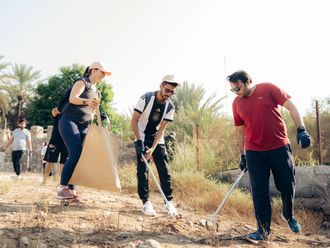An archaeologist has gathered new evidence that proves the existence of the world's oldest known falaj – the ancient underground irrigation system – in the Al Ain region.
The findings are based on a detailed scientific study on this ancient water system, traces of which are found in many countries of Asia, Central Asia and the Middle East.
The falaj system existed in the Al Ain region at about 1,000 years BC, making it the oldest, said Dr Walid Yasin Al Tikriti, Adviser of Archaeology at the Department of Antiquities and Tourism in Al Ain.
Dr Al Tikriti, who conducted the research, said in an exclusive interview with Gulf News that the falaj system in Iran was generally considered the world's oldest, but not a single Iranian falaj goes back to this period.
The falaj system is a network of underground water channels that was mainly used for irrigation in the Al Ain region, Oman, Iran, Balochistan province of Pakistan, Afghanistan, the CIS States, Spain and other countries in Europe, and many countries in the Middle East.
It existed mainly in the arid zones where people devised the underground channels to bring water from distant sources to their land. "It was a highly mature capability based on the people's skills in engineering, water exploration, digging, and maintenance," said the archaeologist.
The ingenuity of the falaj constructors can be judged by the fact that many aflaj (plural of falaj) are still the main source of irrigation in Al Ain and other countries. In Balochistan many areas are still dependent on this system, locally known as Karez.
Dr Al Tikriti, who has been working in the UAE for 30 years, has compiled his research in a book Al Aflaj that has recently been published in Arabic. He is currently preparing to translate his research work in English.
The publishing cost of the book, containing 162 pages, has been born by Sheikh Dhiyab bin Zayed Al Nahyan, Director General of the Presidential Court. The book, which is dedicated to President His Highness Sheikh Zayed bin Sultan Al Nahyan, carries 65 colour pictures and 31 maps.
The study discusses the origin, history and the engineering aspect of the falaj system.
Dr Al Tikriti paid tributes to Sheikh Zayed for his initiatives for water search, restoration of falaj system and preservation of heritage and cultural assets of the country. "Falaj is the most precious heritage and the nation must be proud of having used such a sophisticated system in ancient times."
Sheikh Zayed, as the governor of Al Ain, was the first person to declare water a free commodity for all in 1946, as it was sold earlier. He also launched a programme for the restoration and renovation of water resources that included the falaj system.
This restoration programme took 18 years and provided the lifeline to the region's present thriving agricultural boom.
Talking about the early settlements in the area, Dr Tikriti said the archaeological findings prove the existence of early settlements in the region. These finding trace these settlements as far back as the Bronze and Iron ages.
The Al Ain region was home to many tribes and many of them were highly skilled in the construction of falaj systems. The first known tribe that was considered masters in this art was Al Awamir.
"This tribe specialised in falaj construction and its descendants are still living in the area." He said many Aflaj have been found in Al Ain and its surrounding areas.
Some of these channels are 3,000 years old. Two old Aflaj have also been found in Maiyser and Raki areas of Oman.
The Iron Age Aflaj have been found in Al Ain's Hili, Bida bin Saoud, Jebeeb and Al Madam areas. One falaj has recently been discovered in Thugaibah. Work is going on to document its age and other details.
The archaeologist said the system is an asset, and the government has been doing a lot to preserve and maintain it to show the craftsmanship of older generations to the future ones.
New evidence shows falaj in Al Ain is world's oldest
An archaeologist has gathered new evidence that proves the existence of the world's oldest known falaj – the ancient underground irrigation system – in the Al Ain region.












